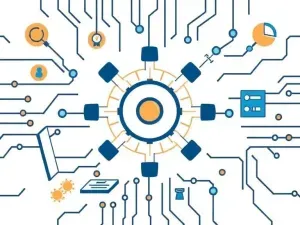Introduction to Real-Time Processing
In today's era of massive data, the ability to process information in real-time has become a critical requirement for businesses and organizations. Traditional batch processing architectures are no longer sufficient to handle continuous data streams with strict latency requirements.
Real-time processing involves analyzing data as soon as it's generated, enabling immediate decision-making based on up-to-date information. This is vital for use cases such as:
- Personalized recommendation systems
- Fraud detection in financial transactions
- Industrial equipment monitoring (IoT)
- Sentiment analysis on social media
Key Components of a Real-Time Architecture
1. Data Ingestion
The first layer of any real-time processing system is the ingestion mechanism. Apache Kafka has become the de facto standard for this purpose.
Properties props = new Properties();
props.put("bootstrap.servers", "kafka1:9092,kafka2:9092");
props.put("key.serializer", "org.apache.kafka.common.serialization.StringSerializer");
props.put("value.serializer", "org.apache.kafka.common.serialization.StringSerializer");
Producer<String, String> producer = new KafkaProducer<>(props);
ProducerRecord<String, String> record = new ProducerRecord<>("topic-name", "key", "value");
producer.send(record);
producer.close();
Critical parameters to configure in Kafka:
- Replication factor (3 for production environments)
- Partition count (based on expected throughput)
- Retention period (message retention time)
- Compression type (snappy or lz4 for better performance)
2. Stream Processing
Once data is in the system, we need processing engines capable of handling continuous streams. The main options are:
Apache Flink: Offers exactly-once processing with low latency
Apache Spark Streaming: Provides micro-batch processing with high fault tolerance
val env = StreamExecutionEnvironment.getExecutionEnvironment
val text = env.socketTextStream("localhost", 9999)
val counts = text.flatMap { _.toLowerCase.split("\\W+") }
.map { (_, 1) }
.keyBy(0)
.timeWindow(Time.seconds(5))
.sum(1)
counts.print()
env.execute("WordCount Example")
3. Results Storage
Processing results need to be stored in systems capable of handling high write rates:
- OLTP Databases: Cassandra, ScyllaDB
- Analytical Storage: ClickHouse, Druid
- Data Lakes: Delta Lake, Iceberg
from cassandra.cluster import Cluster
cluster = Cluster(['cassandra1', 'cassandra2'])
session = cluster.connect()
session.execute("""
CREATE KEYSPACE IF NOT EXISTS streaming_data
WITH replication = {'class': 'NetworkTopologyStrategy', 'datacenter1': 3}
""")
session.execute("""
CREATE TABLE IF NOT EXISTS streaming_data.events (
event_id uuid PRIMARY KEY,
event_time timestamp,
user_id text,
payload text
)
""")
Proven Architectural Patterns
1. Lambda Architecture
Combines batch and real-time processing layers:
- Batch Layer: Complete processing of historical data
- Speed Layer: Incremental real-time processing
- Serving Layer: Merged results for queries
Advantages:
- Provides eventual consistency
- Fault-tolerant
- Combines batch accuracy with streaming speed
Disadvantages:
- Operational complexity
- Need to maintain two logical pipelines
2. Kappa Architecture
Evolution of Lambda that simplifies using only streaming:
- All data flows as streams
- Reprocessing via event replay
- State calculated from historical streams
// Reprocessing example in Kappa with Kafka
Properties props = new Properties();
props.put("bootstrap.servers", "kafka:9092");
props.put("group.id", "data-reprocessor");
props.put("auto.offset.reset", "earliest"); // Start from beginning
KafkaConsumer<String, String> consumer = new KafkaConsumer<>(props);
consumer.subscribe(Collections.singletonList("events-topic"));
while (true) {
ConsumerRecords<String, String> records = consumer.poll(Duration.ofMillis(100));
for (ConsumerRecord<String, String> record : records) {
// Reprocess each event
processEvent(record.value());
}
}
Kappa Advantages:
- Unified architecture
- Simpler to operate
- Less code duplication
Challenges:
- Requires efficient storage systems
- Need to handle state across long time windows
Performance Optimization
Partitioning and Parallelism
Performance in distributed systems critically depends on:
- Number of partitions: Should match desired parallelism
- Partition keys: Uniform distribution is essential
- Stateful operations: Data locality
# Parallelism configuration example in Flink Python API
env = StreamExecutionEnvironment.get_execution_environment()
env.set_parallelism(16) # 16 parallel tasks
env.set_max_parallelism(32) # Maximum scalability
State Management
Modern streaming engines handle state in a distributed manner:
- Operator state: Data associated with a specific key
- Key-value state: Distributed storage
- State backends: Filesystem, RocksDB, memory
val stream: DataStream[Event] = ...
val stateDescriptor = new ValueStateDescriptor[UserProfile](
"userProfile",
classOf[UserProfile])
val processed = stream
.keyBy(_.userId)
.process(new KeyedProcessFunction[String, Event, Result] {
private var state: ValueState[UserProfile] = _
override def open(parameters: Configuration): Unit = {
state = getRuntimeContext.getState(stateDescriptor)
}
override def processElement(
event: Event,
ctx: KeyedProcessFunction[String, Event, Result]#Context,
out: Collector[Result]): Unit = {
// Access and update state
val current = state.value()
val updated = processEvent(current, event)
state.update(updated)
out.collect(createResult(updated))
}
})
Checkpointing and Recovery
To guarantee exactly-once processing:
- Consistent snapshots: Periodically capture system state
- Barriers: Signals that travel with the data
- Two-phase commit algorithms
# Typical Flink checkpoint configuration
state.backend: rocksdb
state.checkpoints.dir: hdfs://namenode:8020/flink/checkpoints
state.backend.rocksdb.ttl.compaction.filter.enabled: true
execution.checkpointing.interval: 60s
execution.checkpointing.mode: EXACTLY_ONCE
execution.checkpointing.timeout: 10min
Security and Governance in Real-Time
Access Control
Distributed systems need mechanisms for:
- Authentication: Kerberos, TLS/SSL
- Authorization: ACLs, RBAC
- Encryption: Data in transit and at rest
# Kafka security configuration
security.protocol=SASL_SSL
sasl.mechanism=SCRAM-SHA-512
ssl.truststore.location=/path/to/truststore.jks
ssl.truststore.password=password
sasl.jaas.config=org.apache.kafka.common.security.scram.ScramLoginModule required \
username="admin" \
password="secret";
Data Quality
Essential metrics to monitor:
- Point latency: Time between event generation and processing
- Throughput: Events per second
- Watermarks: Temporal progress measure
- Backpressure: Bottleneck indicator
// Example Prometheus metrics dashboard
{
"metrics": [
{
"name": "flink_taskmanager_job_latency",
"help": "End-to-end latency in milliseconds",
"type": "GAUGE"
},
{
"name": "kafka_consumer_message_rate",
"help": "Messages consumed per second",
"type": "COUNTER"
},
{
"name": "flink_job_backpressure",
"help": "Indication of backpressure (1 = backpressured)",
"type": "GAUGE"
}
]
}
Real-World Case Studies
Real-Time Recommendation System
Architecture:
- Ingestion: Kafka (500K events/second)
- Processing: Flink (5-minute windows)
- Storage: Redis (feature store)
- Models: TensorFlow Serving updated hourly
# Recommendation pipeline pseudocode
def process_user_event(event):
# Update user profile in state
user_profile = state_store.get(event.user_id)
updated_profile = update_profile(user_profile, event)
state_store.put(event.user_id, updated_profile)
# Generate recommendations
features = build_features(updated_profile)
recommendations = model_predict(features)
# Send to output queue
output_queue.publish({
'user_id': event.user_id,
'items': recommendations,
'timestamp': event.timestamp
})
Fraud Detection Platform
Requirements:
- Maximum latency: 200ms
- Fault tolerance: 99.999%
- Volume: 1M+ transactions/day
Solution:
- Kafka Streams for real-time aggregations
- Complex rules in Flink CEP
- ML models for anomaly detection
// Complex pattern detection with Flink CEP
Pattern<Transaction, ?> fraudPattern = Pattern.<Transaction>begin("first")
.where(new SimpleCondition<Transaction>() {
@Override
public boolean filter(Transaction value) {
return value.getAmount() > 10000;
}
})
.next("second")
.where(new SimpleCondition<Transaction>() {
@Override
public boolean filter(Transaction value) {
return value.getMerchant().equals("highrisk");
}
})
.within(Time.minutes(10));
CEP.pattern(transactionStream, fraudPattern)
.process(new FraudPatternProcessFunction())
.addSink(new AlertSink());
Future of Real-Time Processing
Emerging Trends
- Streaming SQL: Declarative languages for processing
-- Example continuous query in Flink SQL
CREATE TABLE user_clicks (
user_id STRING,
page_url STRING,
click_time TIMESTAMP(3),
WATERMARK FOR click_time AS click_time - INTERVAL '5' SECOND
) WITH (
'connector' = 'kafka',
'topic' = 'clicks',
'properties.bootstrap.servers' = 'kafka:9092',
'format' = 'json'
);
SELECT
user_id,
COUNT(*) AS click_count,
HOP_START(click_time, INTERVAL '30' SECOND, INTERVAL '5' MINUTE) AS window_start
FROM user_clicks
GROUP BY
HOP(click_time, INTERVAL '30' SECOND, INTERVAL '5' MINUTE),
user_id;
-
Serverless Architectures: FaaS for processing
-
ML Integration: Continuously updated models
Pending Challenges
- Strong consistency in distributed systems
- Cross-datacenter processing with low latency
- Debugging complex pipelines
- Cost optimization in the cloud
Conclusion
Real-time Big Data processing has evolved from being a specialized capability to becoming a fundamental requirement for modern organizations. The presented architectures, combined with tools like Kafka, Flink, and Spark, provide the foundation for building scalable systems capable of handling massive data volumes with strict latency requirements.
The key to successful implementations lies in:
- Selecting the appropriate architectural pattern for the use case
- Carefully designing partitioning and state management strategies
- Implementing robust monitoring and recovery mechanisms
- Staying updated with emerging trends in the streaming space
As technologies continue to evolve, real-time architectures will become even more accessible and powerful, enabling organizations to derive value from their data at the moment it's generated.






